Gamma Ray Shielding Properties of Yb3+-Doped Calcium Borotellurite Glasses
Abstract
:1. Introduction
2. Materials and Methods
- 10TeO2-54B2O3-25.5CaO-10CaF2-0.5Yb2O3 (TeBYb1), the density is 3.08 g/cm3
- 16TeO2-50.4B2O3-23.1CaO-10CaF2- 0.5Yb2O3 (TeBYb2), the density is 3.25 g/cm3
- 22TeO2-46.8B2O3-20.7CaO-10CaF2- 0.5Yb2O3 (TeBYb3), the density is 3.43 g/cm3
- 31TeO2-41.4B2O3-17.1CaO-10CaF2- 0.5Yb2O3 (TeBYb4), the density is 3.71 g/cm3
- 54TeO2-27.6B2O3-7.9CaO-10CaF2- 0.5Yb2O3 (TeBYb5), the density is 4.46 g/cm3
3. Results and Discussion
4. Conclusions
Author Contributions
Funding
Institutional Review Board Statement
Informed Consent Statement
Data Availability Statement
Conflicts of Interest
References
- Kaewjaeng, S.; Kothan, S.; Chaiphaksa, W.; Chanthima, N.; Rajaramakrishna, R.; Kim, H.J.; Kaewkhao, J. High transparency La2O3-CaO-B2O3-SiO2 glass for diagnosis x-rays shielding material application. Radiat. Phys. Chem. 2019, 160, 41–47. [Google Scholar] [CrossRef]
- Kaewjang, S.; Maghanemi, U.; Kothan, S.; Kim, H.; Limkitjaroenporn, P.; Kaewkhao, J. New gadolinium based glasses for gamma-rays shielding materials. Nucl. Eng. Des. 2014, 280, 21–26. [Google Scholar] [CrossRef]
- Sayyed, M.I.; Jecong, J.F.M.; Hila, F.C.; Balderas, C.V.; Alhuthali, A.M.; Guillermo, N.R.D.; Al-Hadeethi, Y. Radiation shielding characteristics of selected ceramics using the EPICS2017 library. Ceram. Int. 2021, 47, 13181–13186. [Google Scholar] [CrossRef]
- Dong, M.; Xue, X.; Yang, H.; Li, Z. Highly cost-effective shielding composite made from vanadium slag and boron-rich slag and its properties. Radiat. Phys. Chem. 2017, 141, 239–244. [Google Scholar] [CrossRef]
- Sayyed, M.; Mhareb, M.; Alajerami, Y.; Mahmoud, K.; Imheidat, M.A.; Alshahri, F.; Alqahtani, M.; Al-Abdullah, T. Optical and radiation shielding features for a new series of borate glass samples. Optik 2021, 239, 166790. [Google Scholar] [CrossRef]
- Aygün, B. High alloyed new stainless steel shielding material for gamma and fastneutron radiation. Nucl. Eng. Technol. 2020, 52, 647–653. [Google Scholar] [CrossRef]
- Reda, A.; El-Daly, A. Gamma ray shielding characteristics of Sn-20Bi and Sn-20Bi-0.4Cu lead-free alloys. Prog. Nucl. Energy 2020, 123, 103304. [Google Scholar] [CrossRef]
- Kaewjaeng, S.; Kothan, S.; Chanthima, N.; Kim, H.; Kaewkhao, J. Gamma radiation shielding materials of lanthanum calcium silicoborate glasses. Mater. Today Proc. 2018, 5, 14901–14906. [Google Scholar] [CrossRef]
- Obaid, S.S.; Gaikwad, D.K.; Pawar, P.P. Determination of gamma ray shielding parameters of rocks and concrete. Radiat. Phys. Chem. 2018, 144, 356–360. [Google Scholar] [CrossRef]
- Kumar, A. Gamma ray shielding properties of PbO-Li2O-B2O3 glasses. Radiat. Phys. Chem. 2017, 136, 50–53. [Google Scholar] [CrossRef]
- Monisha, M.; D’Souza, A.N.; Hegde, V.; Prabhu, N.S.; Sayyed, M.I.; Lakshminarayana, G.; Kamath, S.D. Dy3+ doped SiO2–B2O3–Al2O3–NaF–ZnF2 glasses: An exploration of optical and gamma radiation shielding features. Curr. Appl. Phys. 2020, 20, 1207–1216. [Google Scholar] [CrossRef]
- Sayyed, M.I.; Olarinoye, O.I.; Elsafi, M. Assessment of gamma-radiation attenuation characteristics of Bi2O3–B2O3–SiO2–Na2O glasses using Geant4 simulation code. Eur. Phys. J. Plus 2021, 136, 535. [Google Scholar] [CrossRef]
- Chanthima, N.; Kaewkhao, J.; Limkitjaroenporn, P.; Tuscharoen, S.; Kothan, S.; Tungjai, M.; Kaewjaeng, S.; Sarachai, S.; Limsuwan, P. Development of BaO–ZnO–B2O3 glasses as a radiation shielding material. Radiat. Phys. Chem. 2017, 137, 72–77. [Google Scholar] [CrossRef]
- Almuqrin, A.H.; Sayyed, M.I. Radiation shielding characterizations and investigation of TeO2–WO3–Bi2O3 and TeO2–WO3–PbO glasses. Appl. Phys. A 2021, 127, 190. [Google Scholar] [CrossRef]
- Sayyed, M.; Mahmoud, K.; Tashlykov, O.; Khandaker, M.U.; Faruque, M. Enhancement of the Shielding Capability of Soda–Lime Glasses with Sb2O3 Dopant: A Potential Material for Radiation Safety in Nuclear Installations. Appl. Sci. 2020, 11, 326. [Google Scholar] [CrossRef]
- Ersundu, M.Ç.; Ersundu, A.E.; Gedikoğlu, N.; Şakar, E.; Büyükyıldız, M.; Kurudirek, M. Physical, mechanical and gam-ma-ray shielding properties of highly transparent ZnO-MoO3-TeO2 glasses. J. Non-Cryst. Solids 2019, 524, 119648. [Google Scholar] [CrossRef]
- Rammah, Y.; Ali, A.; El-Mallawany, R.; El-Agawany, F. Fabrication, physical, optical characteristics and gamma-ray competence of novel bismo-borate glasses doped with Yb2O3 rare earth. Phys. B Condens. Matter 2020, 583, 412055. [Google Scholar] [CrossRef]
- Klimesz, B.; Lisiecki, R.; Ryba-Romanowski, W. Sm3+-doped oxyfluorotellurite glasses—Spectroscopic, luminescence and temperature sensor properties. J. Alloys Compd. 2019, 788, 658–e665. [Google Scholar] [CrossRef]
- Elkholy, H.; Othman, H.; Hager, I.; Ibrahim, M.; De Ligny, D. Thermal and optical properties of binary magnesium tellurite glasses and their link to the glass structure. J. Alloy. Compd. 2020, 823, 153781. [Google Scholar] [CrossRef]
- Halimah, M.; Azuraida, A.; Ishak, M.; Hasnimulyati, L. Influence of bismuth oxide on gamma radiation shielding properties of boro-tellurite glass. J. Non-Cryst. Solids 2019, 512, 140–147. [Google Scholar] [CrossRef]
- Stalin, S.; Gaikwad, D.; Samee, M.; Edukondalu, A.; Ahmmad, S.K.; Joshi, A.; Syed, R. Structural, optical features and gamma ray shielding properties of Bi2O3–TeO2–B2O3-GeO2 glass system. Ceram. Int. 2020, 46, 17325–17334. [Google Scholar] [CrossRef]
- Sayyed, M.; Al-Hadeethi, Y.; AlShammari, M.M.; Ahmed, M.; Al-Heniti, S.H.; Rammah, Y. Physical, optical and gamma radiation shielding competence of newly boro-tellurite based glasses: TeO2–B2O3–ZnO–Li2O3–Bi2O3. Ceram. Int. 2021, 47, 611–618. [Google Scholar] [CrossRef]
- Paz, E.; Dias, J.; Melo, G.; Lodi, T.; Carvalho, J.D.O.; Filho, P.F.; Barboza, M.J.; Pedrochi, F.; Steimacher, A. Physical, thermal and structural properties of Calcium Borotellurite glass system. Mater. Chem. Phys. 2016, 178, 133–138. [Google Scholar] [CrossRef]
- Paz, E.; Lodi, T.A.; Gomes, B.; Melo, G.; Pedrochi, F.; Steimacher, A. Optical and spectroscopic investigation on Calcium Borotellurite glass system. Solid State Sci. 2016, 55, 106–111. [Google Scholar] [CrossRef]
- Lima, A.; Gomes, J.; Hegeto, F.; Medina, A.; Steimacher, A.; Barboza, M.J. Evaluation of TeO2 content on the optical and spectroscopic properties of Yb3+-doped calcium borotellurite glasses. Spectrochim. Acta Part. A Mol. Biomol. Spectrosc. 2018, 193, 212–218. [Google Scholar] [CrossRef] [PubMed]
- Singh, V.P.; Medhat, M.; Shirmardi, S. Comparative studies on shielding properties of some steel alloys using Geant4, MCNP, WinXCOM and experimental results. Radiat. Phys. Chem. 2015, 106, 255–260. [Google Scholar] [CrossRef]
- Gerward, L.; Guilbert, N.; Jensen, K.; Levring, H. WinXCom—A program for calculating X-ray attenuation coefficients. Radiat. Phys. Chem. 2004, 71, 653–654. [Google Scholar] [CrossRef]
- Şakar, E.; Özpolat, Ö.F.; Alım, B.; Sayyed, M.I.; Kurudirek, M. Phy-X/PSD: Development of a user friendly online software for calculation of parameters relevant to radiation shielding and dosimetry. Radiat. Phys. Chem. 2020, 166, 108496. [Google Scholar] [CrossRef]
- Singh, V.P.; Badiger, N. Energy absorption buildup factors, exposure buildup factors and Kerma for optically stimulated luminescence materials and their tissue equivalence for radiation dosimetry. Radiat. Phys. Chem. 2014, 104, 61–67. [Google Scholar] [CrossRef]
- Nagaraja, N.; Manjunatha, H.; Seenappa, L.; Sridhar, K.; Ramalingam, H. Radiation shielding properties of silicon polymers. Radiat. Phys. Chem. 2020, 171, 108723. [Google Scholar] [CrossRef]
- Sayyed, M.I.; Almuqrin, A.H.; Kumar, A.; Jecong, J.F.M.; Akkurt, I. Optical, mechanical properties of TeO2-CdO-PbO-B2O3 glass systems and radiation shielding investigation using EPICS2017 library. Optik 2021, 242, 167342. [Google Scholar] [CrossRef]
- Mhareb, M.H.A.; Alajerami, Y.S.M.; Sayyed, M.I.; Dwaikat, N.; Alqahtani, M.; Alshahri, F.; Saleh, N.; Alonizan, N.; Ghrib, T.; Al-Dhafar, S.I. Radiation shielding, structural, physical, and optical properties for a series of borosilicate glass. J. Non-Cryst. Solids 2020, 550, 120360. [Google Scholar] [CrossRef]
- Sharma, R.; Sharma, V.; Singh, P.S.; Singh, T. Effective atomic numbers for some calcium–strontium-borate glasses. Ann. Nucl. Energy 2012, 45, 144–149. [Google Scholar] [CrossRef]
- Yasmin, S.; Barua, B.S.; Khandaker, M.U.; Chowdhury, F.; Rashid, M.A.; Bradley, D.A.; Olatunji, M.A.; Kamal, M. Studies of ionizing radiation shielding effectiveness of silica-based com-mercial glasses used in Bangladeshi dwellings. Results Phys. 2018, 9, 541–549. [Google Scholar] [CrossRef]
- Fuochi, P.; Corda, U.; Lavalle, M.; Kovács, A.; Baranyai, M.; Mejri, A.; Farah, K. Dosimetric properties of gamma and electron-irradiated commercial window glasses. Nukleonika 2009, 54, 39–43. [Google Scholar]
- Manohara, S.; Hanagodimath, S.; Thind, K.; Gerward, L. On the effective atomic number and electron density: A comprehensive set of formulas for all types of materials and energies above 1 keV. Nucl. Instrum. Methods Phys. Res. Sect. B Beam Interact. Mater. At. 2008, 266, 3906–3912. [Google Scholar] [CrossRef]
- Kaur, P.; Singh, K.J.; Thakur, S.; Kurudirek, M. Investigation of a competent non-toxic Bi2O3−Li2O−CeO2−MoO3−B2O3 glass system for nuclear radiation security applications. J. Non-Cryst. Solids 2020, 545, 120235. [Google Scholar] [CrossRef]
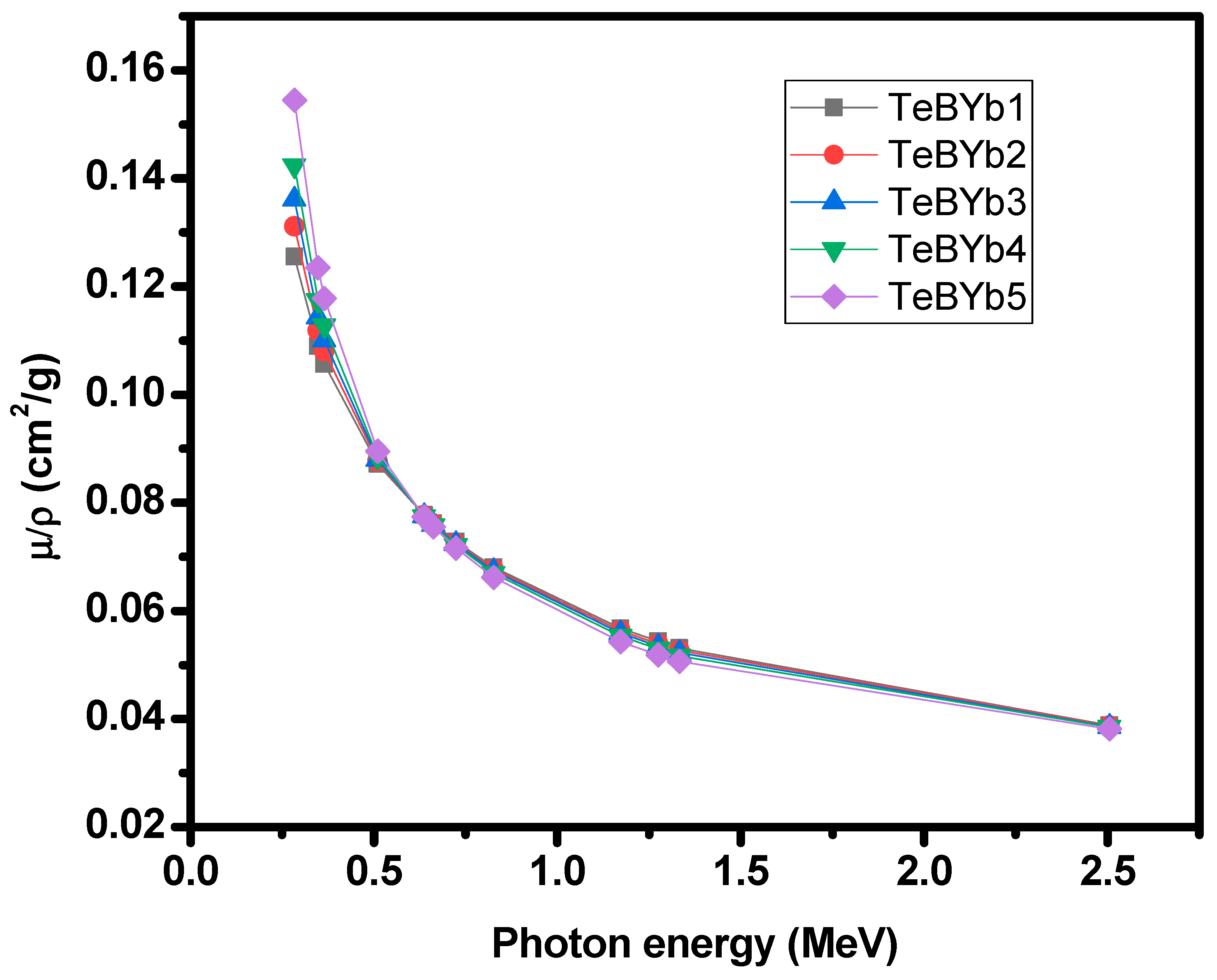

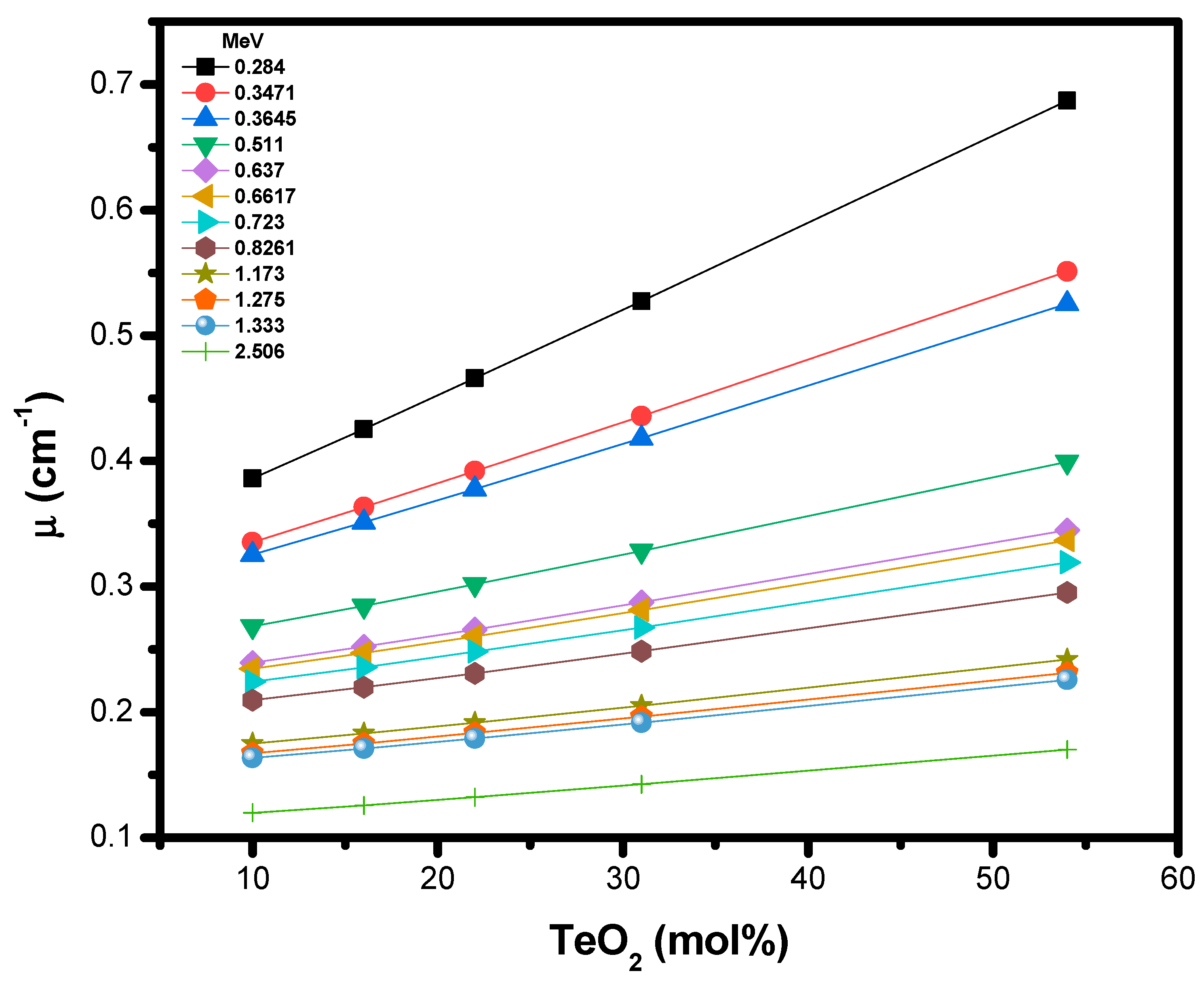
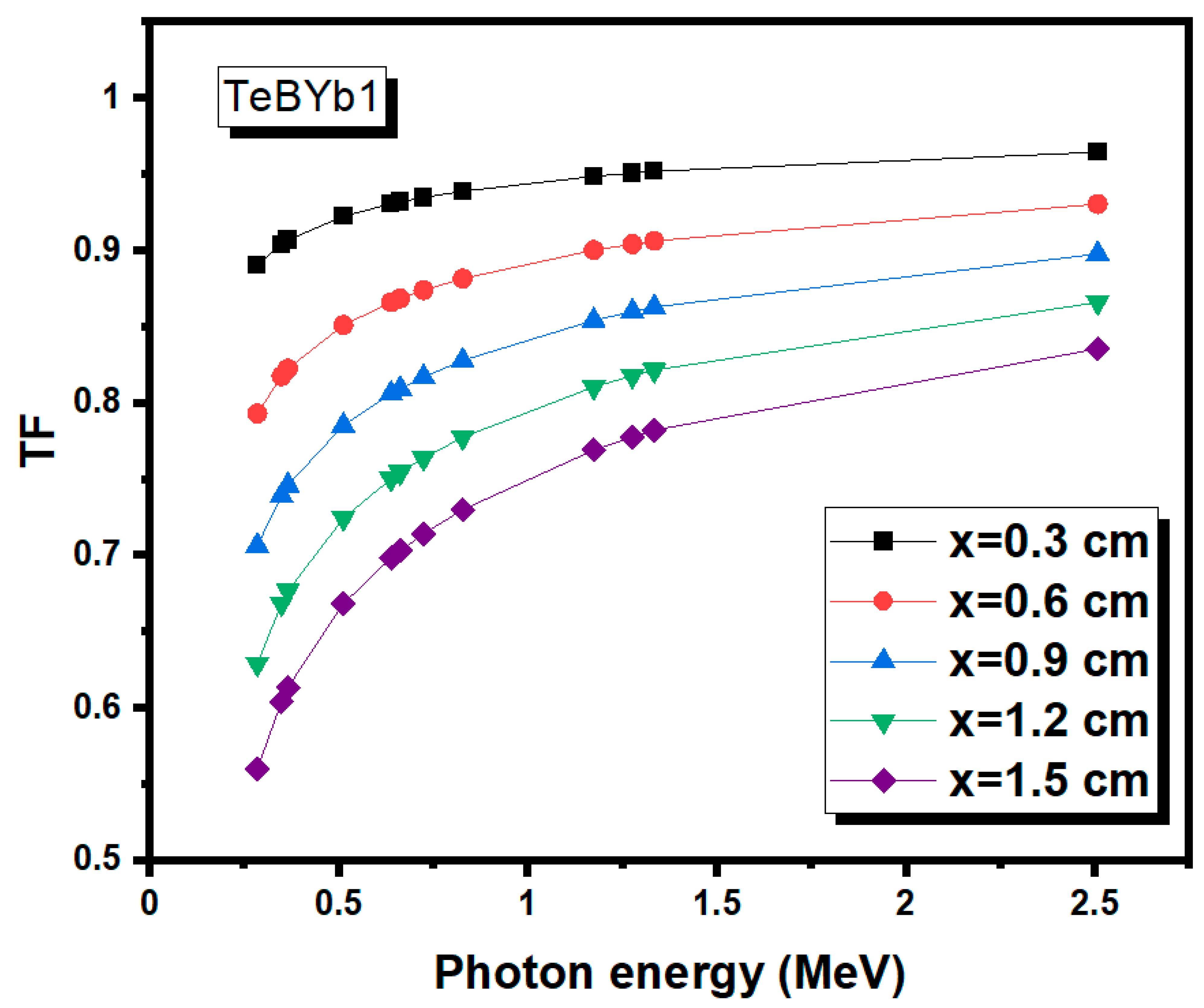
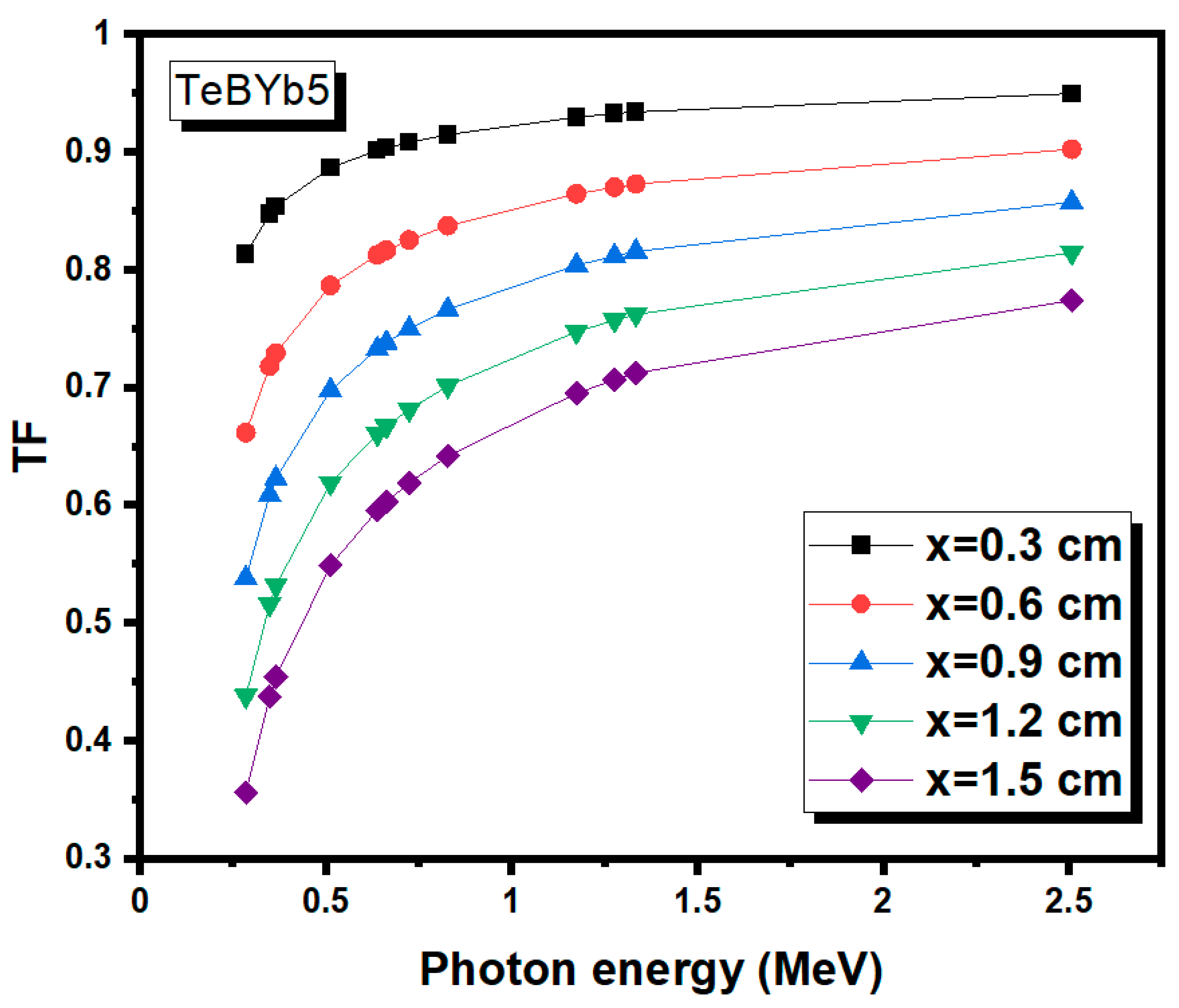


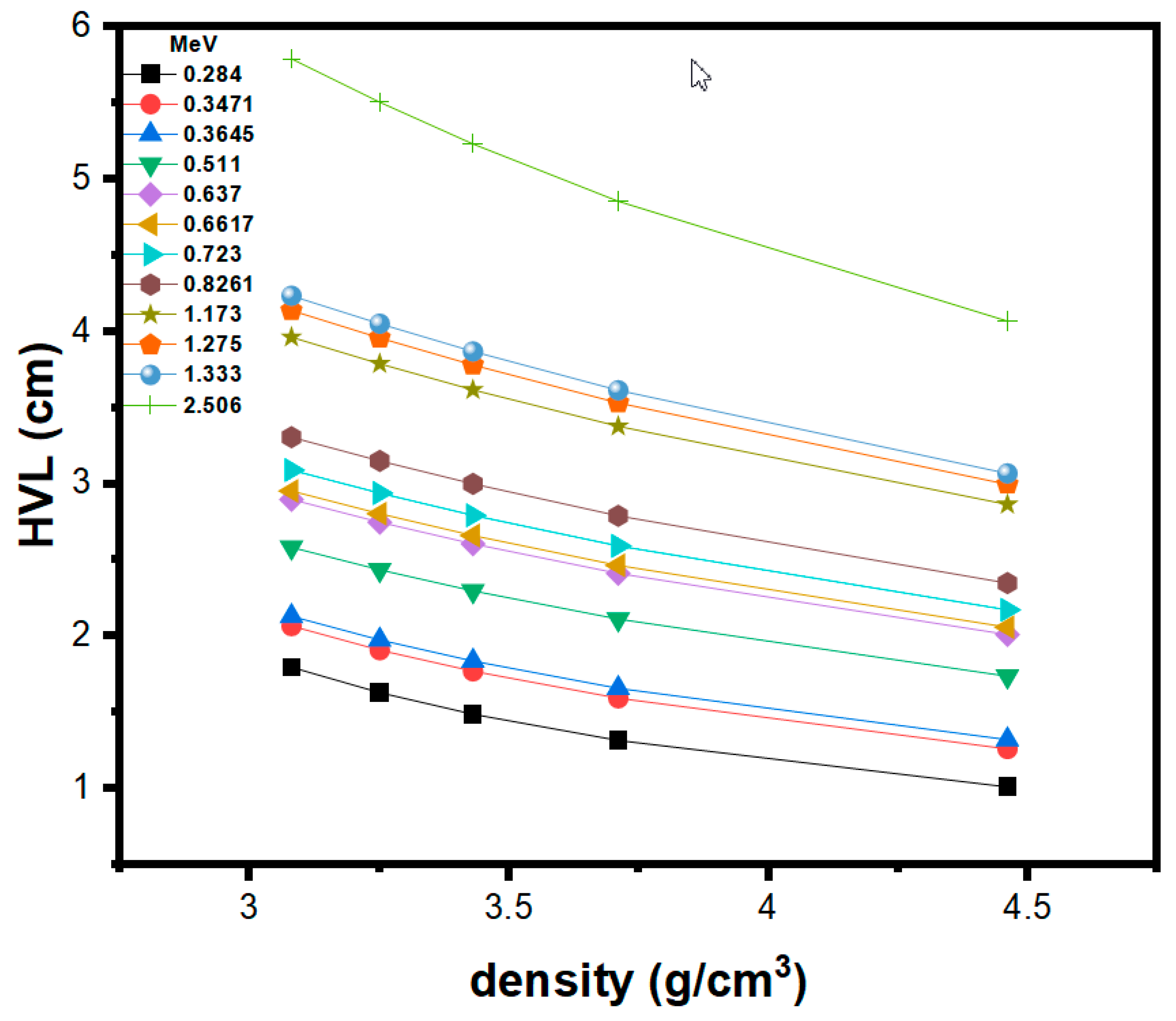

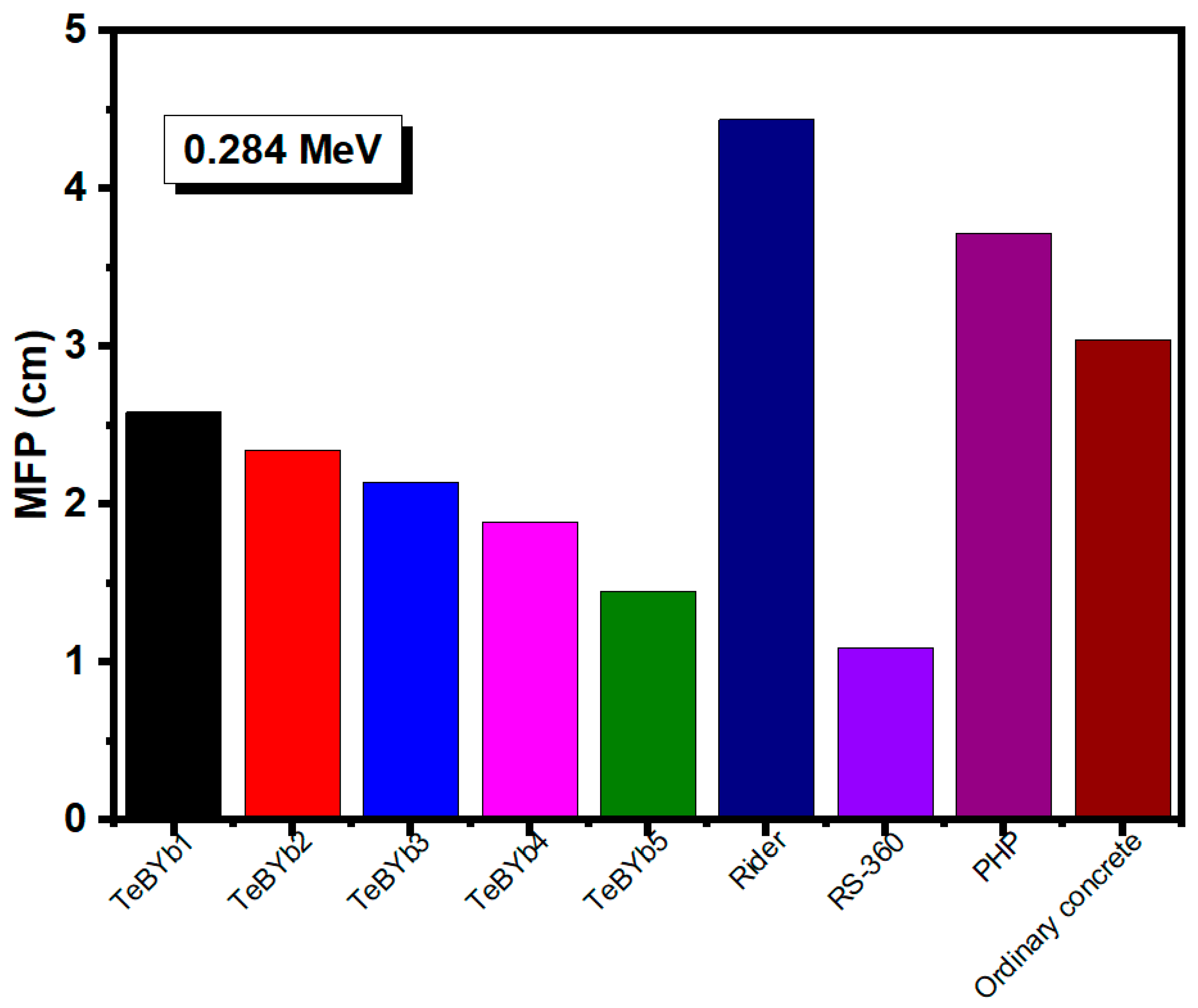
| Sample Code | TeO2 | B2O3 | CaO | CaF2 | Yb2O3 | Density (g/cm3) |
|---|---|---|---|---|---|---|
| TeBYb1 | 10 | 54 | 25.5 | 10 | 0.5 | 3.08 |
| TeBYb2 | 16 | 50.4 | 23.1 | 10 | 0.5 | 3.25 |
| TeBYb3 | 22 | 46.8 | 20.7 | 10 | 0.5 | 3.43 |
| TeBYb4 | 31 | 41.4 | 17.1 | 10 | 0.5 | 3.71 |
| TeBYb5 | 54 | 27.6 | 7.9 | 10 | 0.5 | 4.46 |
Publisher’s Note: MDPI stays neutral with regard to jurisdictional claims in published maps and institutional affiliations. |
© 2021 by the authors. Licensee MDPI, Basel, Switzerland. This article is an open access article distributed under the terms and conditions of the Creative Commons Attribution (CC BY) license (https://creativecommons.org/licenses/by/4.0/).
Share and Cite
Almuqrin, A.H.; Sayyed, M.I. Gamma Ray Shielding Properties of Yb3+-Doped Calcium Borotellurite Glasses. Appl. Sci. 2021, 11, 5697. https://doi.org/10.3390/app11125697
Almuqrin AH, Sayyed MI. Gamma Ray Shielding Properties of Yb3+-Doped Calcium Borotellurite Glasses. Applied Sciences. 2021; 11(12):5697. https://doi.org/10.3390/app11125697
Chicago/Turabian StyleAlmuqrin, Aljawhara H., and M. I. Sayyed. 2021. "Gamma Ray Shielding Properties of Yb3+-Doped Calcium Borotellurite Glasses" Applied Sciences 11, no. 12: 5697. https://doi.org/10.3390/app11125697
APA StyleAlmuqrin, A. H., & Sayyed, M. I. (2021). Gamma Ray Shielding Properties of Yb3+-Doped Calcium Borotellurite Glasses. Applied Sciences, 11(12), 5697. https://doi.org/10.3390/app11125697







